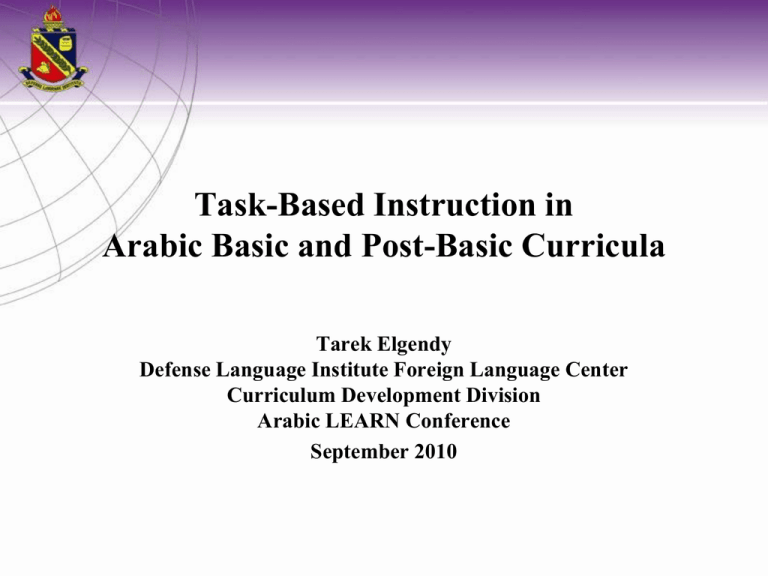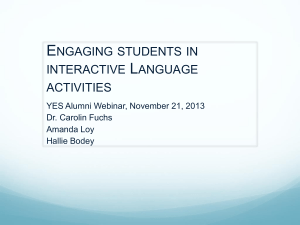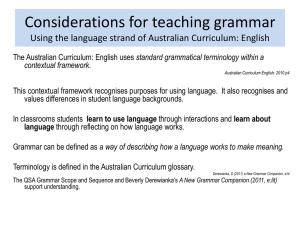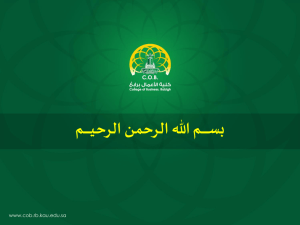Task-Based Instruction in Basic and Post
advertisement

Task-Based Instruction in Arabic Basic and Post-Basic Curricula Tarek Elgendy Defense Language Institute Foreign Language Center Curriculum Development Division Arabic LEARN Conference September 2010 Introduction Tasks Task/Function-based instruction Authentic material and real-life tasks. Thematic/Function-driven scope and sequence. Role of grammar in functionally driven courses. Samples Task-Based Instruction and Communicative Language Teaching Emphasizes communication through interaction. Active involvement in the task Pairs or small groups What is a Task? Nunan (1989) defined a task as “any classroom work which involves learners in comprehension, manipulating, producing, or interacting in the target language while their attention is principally focused on meaning rather than form.” (p.10) “An activity which requires learners to use language, with emphasis on meaning, to attain an objective.” Bygate, Skehan, Swain (2001) Parameters of Task Activity Skehan’s (1998) summary of such parameters: Meaning is primary Learners are not given other people’s meaning to regurgitate There is some sort of relationship to comparable real-world activities Task completion has a priority The assortment of tasks is done in terms of outcome (p.147) Parameters of Task Activity “A task is goal oriented A task involves a primary focus on meaning The participants choose the linguistic resources needed to complete the task A task has a clearly defined outcome.” Rod Ellis Role of teachers Make performance of tasks the objective of any activity The use of authentic tasks is as important as the use of authentic materials Develop multi-step activities Less use of drills, exercises, one-step activities, loose activities Arabic Basic Curriculum Organization and Design of ABC Outline of the ABC Semester III Semester I & II Military Topics • Vocabulary in Context • Grammar in Context Unit 14 • Vocabulary in Context • Grammar in Context Topic Presentation B Chapter 4 Chapter 3 Chapter 2 Chapter 1 Chapter 5 Chapter 4 Chapter 3 Chapter 2 Chapter 1 Topic Presentation A • Vocabulary in Context • Grammar in Context Unit 13 Unit 12 Unit 11 Unit 10 Unit 9 Unit 8 Unit 7 Unit 6 Unit 5 Unit 4 Unit 3 Unit 2 Unit 1 Topic Presentation C ABC Scope and Sequence Topics الموضوع الفرعي Grammar قواعد اللغة Functions وظائف اللغة نصب الفعل المضارع: الهوايات التي التعبير عن تمارس التفضيل Expressingفي مكان مفتوح preference Outdoor s activities لعب أحب َ ُ -الكرة ألعب أحب أن َ ُ -الكرة Theme الموضوع الرئيس الهوايات الشخصية Hobbies Role of Grammar Role of grammar in TBI: Facilitating the learners’ performance of the task The goal of embedding grammar in the topic is to help achieve functional, cognitive, or emotional objectives. الهدف من نسج قواعد اللغة مع الموضوع هو تيسير أداء وظائف تربوية معينة ،يمكن أن تكون أهداف الدرس أهداف أدائية مثل طلب وجبة في مطعم أو إدراكية مثل استيعاب مفهوم معين أو عاطفية مثل شعور المتعلمين باإلنجاز أو اكتساب الثقة. Ways for Presenting Grammar: Explicit/Deductive استنتاجي/شرح صريح Implicit/Deductive استنتاجي/ ًمفهوم ضمنا Inductive/Implicit ً مفهوم ضمنا/ حثي Inductive/Explicit شرح صريح/حثي Unit Design Semester 1 - Unit 5: Touring the Arab World Chapter 21: Planning for the Trip Chapter 22: First Leg of the Trip Chapter 23: Touring Egypt Chapter 24: Last Leg of the Trip Chapter 25: Morocco to Kuwait ABC_Ch. Components_Sample Setting and Objectives – Getting Started – Vocabulary in Context • Nile River Cruise – p23.11 • At the Post Office – p23.29 ABC_Unit Components_Sample Grammar in Context • Present Tense Verbs in the ccusative Case - ABC_Main Components_Sample Language in Use Culmination of chapter theme, vocabulary, and grammar A military-driven problem-solving scenario Four-skills integration, task-based activities Presented in real-life situations, using authentic materials Learner-focused classroom Peripheral Components Cultural Note How do Arabs Say it? Functioning in the Real World – Strategy Notes Computer-assisted language games Self-Evaluation Teacher’s Note Arabic Post-Basic Curriculum Arabic PB Course Design C4 C1 C2 C3 6 wks 6 wks 6 wks 6 wks 2 ~ 2+ 1+ ~ 2 1+ ~ 2 2 ~ 2+ C5 C6 C7 C8 6 wks 6 wks 6 wks 6 wks 2+ ~ 3 2+ ~ 3 3 ~ 3+ 3 ~ 3+ Topical Domains (FLO) Geography, Culture and Society, Politics & Economy, Military & Security, Technology & Science APBC Interface Templates Example of Main Page Sample of Peripheral Page Main Activities Introduction _ Spark interest, not deep, not for discussion, Ex. Ask for a view point or speculation Warm-Up _ Vocabulary about the topic, enough socio/cultural background to start with. Main Activities Reading _ Listening _ Grammar Review _ _ _ Mini-Projects _ _ HW _ TTT _ Arabic Sayings _ Cultural Hints _ Peripheral Pages Objectives _ Key Vocabulary _ Resources _ Teacher Guide _ Recap_ Conclusion ABC and APBC are: TB Driven Contemporary Level-driven FLO-oriented Student-centered Standardized Resources Nunan, D. (1989)> Designing tasks for the communicative class. Cambridge, Cambridge University Press. Skehan, P. (1998). Task-based instruction. Annual Review of Applied Linguistics 18, 26886. Ellis, R. (2003). Task-based language learning and teaching. Oxford, Oxford University Press. Discussion tarek.elgendy@us.army.mil (831) 229-7111 Disclaimer This presentation is authorized by the Defense Language Institute Foreign Language Center and the Department of Defense. Contents of this presentation are not necessarily the official views of, or endorsed by, the U.S. Government, Department of Defense, Department of the Army, or the Defense Language Institute Foreign Language Center









